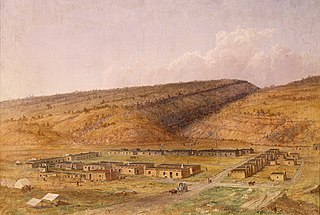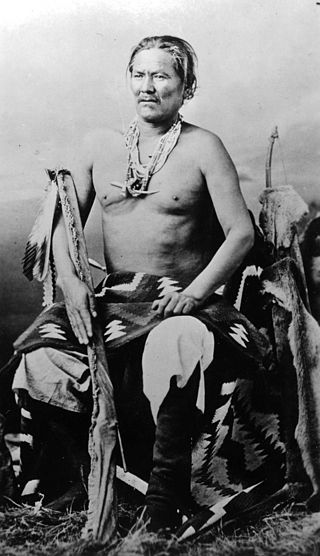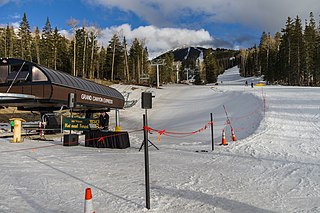
Fort Defiance is a census-designated place (CDP) in Apache County, Arizona, United States. It is also located within the Navajo Nation. The population was 3,624 at the 2010 census.

Dilkon is a census-designated place (CDP) in Navajo County, Arizona, United States. The population was 1,184 at the 2010 census. The name of the town is said to be derived from the Navajo phrase "Smooth black rock" or "Bare surface.”

The Navajo Nation, also known as Navajoland, is a Native American reservation of Navajo people in the United States. It occupies portions of northeastern Arizona, northwestern New Mexico, and southeastern Utah. The seat of government is located in Window Rock, Arizona.
The music of Arizona began with Indigenous music of North America made by Indigenous peoples of Arizona. In the 20th century, Mexican immigrants popularized Banda, corridos, mariachi and conjunto. Other major influences come from styles popular throughout the rest of the United States.
The Apache are several Southern Athabaskan language–speaking peoples of the Southwest, the Southern Plains and Northern Mexico. They are linguistically related to the Navajo. They migrated from the Athabascan homelands in the north into the Southwest between 1000 and 1500 CE.

The Long Walk of the Navajo, also called the Long Walk to Bosque Redondo, was the deportation and ethnic cleansing of the Navajo people by the United States federal government and the United States army. Navajos were forced to walk from their land in western New Mexico Territory to Bosque Redondo in eastern New Mexico. Some 53 different forced marches occurred between August 1864 and the end of 1866. In total, 10,000 Navajos and 500 Mescalero Apache were forced to the internment camp in Bosque Redondo. During the forced march and internment, up to 3,500 people died from starvation and disease over a 4 year period. In 1868, the Navajo were allowed to return to their ancestral homeland following the Treaty of Bosque Redondo. Some anthropologists state that the "collective trauma of the Long Walk...is critical to contemporary Navajos' sense of identity as a people".

Diné College is a public tribal land-grant college based in Tsaile, Arizona, serving the 27,000-square-mile (70,000 km2) Navajo Nation. It offers associate degrees, bachelor's degrees, and academic certificates.

The term Navajo Wars covers at least three distinct periods of conflict in the American West: the Navajo against the Spanish ; the Navajo against the Mexican government ; and the Navajo against the United States. These conflicts ranged from small-scale raiding to large expeditions mounted by governments into territory controlled by the Navajo. The Navajo Wars also encompass the widespread raiding that took place throughout the period; the Navajo raided other tribes and nearby settlements, who in return raided into Navajo territory, creating a cycle of raiding that perpetuated the conflict.

The Tonto Apache is one of the groups of Western Apache people and a federally recognized tribe, the Tonto Apache Tribe of Arizona. The term is also used for their dialect, one of the three dialects of the Western Apache language.

Chief Manuelito or Hastiin Chʼil Haajiní was one of the principal headmen of the Diné people before, during and after the Long Walk Period. Manuelito is the diminutive form of the name Manuel, the Iberian variant of the name Immanuel; Manuelito translates to Little Immanuel. He was born to the Bit'ahnii or ″Folded Arms People Clan″, near the Bears Ears in southeastern Utah about 1818. As many Navajo, he was known by different names depending upon context. He was Ashkii Diyinii, Dahaana Baadaané, Hastiin Ch'ilhaajinii and as Nabááh Jiłtʼaa to other Diné, and non-Navajo nicknamed him "Bullet Hole".

The history of Arizona encompasses the Paleo-Indian, Archaic, Post-Archaic, Spanish, Mexican, and American periods. About 10,000 to 12,000 years ago, Paleo-Indians settled in what is now Arizona. A few thousand years ago, the Ancestral Puebloan, the Hohokam, the Mogollon and the Sinagua cultures inhabited the state. However, all of these civilizations mysteriously disappeared from the region in the 15th and 16th centuries. Today, countless ancient ruins can be found in Arizona. Arizona was part of the state of Sonora, Mexico from 1822, but the settled population was small. In 1848, under the terms of the Mexican Cession the United States took possession of Arizona above the Gila River after the Mexican War, and became part of the Territory of New Mexico. By means of the Gadsden Purchase, the United States secured the northern part of the state of Sonora, which is now Arizona south of the Gila River in 1854.

Navajo tribe are american people of the united states

Arizona Snowbowl is an alpine ski resort in the southwest United States, located on the San Francisco Peaks of northern Arizona, fifteen miles (24 km) north of Flagstaff. The Snowbowl ski area covers approximately one percent of the San Francisco Peaks, and its slopes face west and northwest.

Blackfire is a Native American punk rock group. Composed of two brothers and their sister, their musical style is influenced by traditional Navajo Diné music and alternative rock, with political messages about government oppression and human rights. In 2012, members formed the band Sihasin.

Peterson Zah was an American politician who held several offices with the Navajo Nation. From 1983 to 1987, he was chairman of the Navajo Nation, its then head of government. At its 1991 restructuring, he became the first president of the Navajo Nation, until 1995. He then worked at Arizona State University as special adviser to the president on American Indian Affairs and consulted companies willing to work with his nation.

Peter MacDonald is a Native American politician and the only four term Chairman of the Navajo Nation. MacDonald was born in Arizona, U.S. and served the U.S. Marine Corps in World War II as a Navajo Code Talker. He was first elected Navajo Tribal Chairman in 1970.

Harrison Begay, also known as Haashké yah Níyá was a renowned Diné (Navajo) painter, printmaker, and illustrator. Begay specialized in watercolors, gouache, and silkscreen prints. At the time of his death in 2012, he was the last living, former student of Dorothy Dunn and Geronima C. Montoya at the Santa Fe Indian School. His work has won multiple awards and is exhibited in museums and private collections worldwide and he was among the most famous Diné artists of his generation.
Evelyne E. Bradley was an American Navajo judge. She served as a district judge for the Navajo Nation from 1984 until her retirement in 1995. Bradley was one of the first women to become a judge within the Navajo Nation.

Sihasin is a Diné band consisting of brother and sister duo, Clayson and Jeneda Benally. The band's name, "Sihasin", translates to "hope" in the Diné language. The band is from Flagstaff, Arizona, and their music is based in Diné culture, activism and punk rock.

Diné CARE is a Diné (Navajo) activist organization that works on environmental, cultural and social justice campaigns, primarily within the Navajo Nation and the immediately surrounding areas. Diné CARE stands for Diné Citizens Against Ruining Our Environment and helped build the early environmental justice movement in the United States. Their work has included opposing the creation of toxic waste infrastructure, polluting energy infrastructure, industrial-scale logging, advocating for compensation for people impacted by uranium mining and weapons development as well as against business practices that facilitate abuse of alcohol in nearby Gallup.















